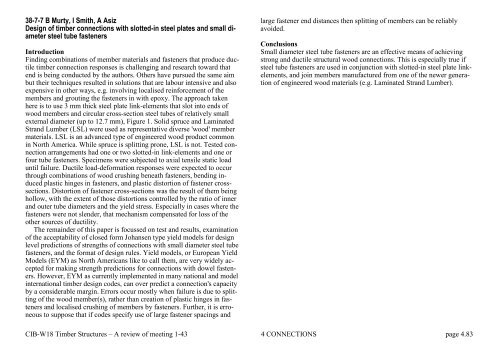Download pdf - CIB-W18
Download pdf - CIB-W18
Download pdf - CIB-W18
- TAGS
- download
- cib-w18.com
You also want an ePaper? Increase the reach of your titles
YUMPU automatically turns print PDFs into web optimized ePapers that Google loves.
38-7-7 B Murty, I Smith, A Asiz<br />
Design of timber connections with slotted-in steel plates and small diameter<br />
steel tube fasteners<br />
Introduction<br />
Finding combinations of member materials and fasteners that produce ductile<br />
timber connection responses is challenging and research toward that<br />
end is being conducted by the authors. Others have pursued the same aim<br />
but their techniques resulted in solutions that are labour intensive and also<br />
expensive in other ways, e.g. involving localised reinforcement of the<br />
members and grouting the fasteners in with epoxy. The approach taken<br />
here is to use 3 mm thick steel plate link-elements that slot into ends of<br />
wood members and circular cross-section steel tubes of relatively small<br />
external diameter (up to 12.7 mm), Figure 1. Solid spruce and Laminated<br />
Strand Lumber (LSL) were used as representative diverse 'wood' member<br />
materials. LSL is an advanced type of engineered wood product common<br />
in North America. While spruce is splitting prone, LSL is not. Tested connection<br />
arrangements had one or two slotted-in link-elements and one or<br />
four tube fasteners. Specimens were subjected to axial tensile static load<br />
until failure. Ductile load-deformation responses were expected to occur<br />
through combinations of wood crushing beneath fasteners, bending induced<br />
plastic hinges in fasteners, and plastic distortion of fastener crosssections.<br />
Distortion of fastener cross-sections was the result of them being<br />
hollow, with the extent of those distortions controlled by the ratio of inner<br />
and outer tube diameters and the yield stress. Especially in cases where the<br />
fasteners were not slender, that mechanism compensated for loss of the<br />
other sources of ductility.<br />
The remainder of this paper is focussed on test and results, examination<br />
of the acceptability of closed form Johansen type yield models for design<br />
level predictions of strengths of connections with small diameter steel tube<br />
fasteners, and the format of design rules. Yield models, or European Yield<br />
Models (EYM) as North Americans like to call them, are very widely accepted<br />
for making strength predictions for connections with dowel fasteners.<br />
However, EYM as currently implemented in many national and model<br />
international timber design codes, can over predict a connection's capacity<br />
by a considerable margin. Errors occur mostly when failure is due to splitting<br />
of the wood member(s), rather than creation of plastic hinges in fasteners<br />
and localised crushing of members by fasteners. Further, it is erroneous<br />
to suppose that if codes specify use of large fastener spacings and<br />
large fastener end distances then splitting of members can be reliably<br />
avoided.<br />
Conclusions<br />
Small diameter steel tube fasteners are an effective means of achieving<br />
strong and ductile structural wood connections. This is especially true if<br />
steel tube fasteners are used in conjunction with slotted-in steel plate linkelements,<br />
and join members manufactured from one of the newer generation<br />
of engineered wood materials (e.g. Laminated Strand Lumber).<br />
<strong>CIB</strong>-<strong>W18</strong> Timber Structures – A review of meeting 1-43 4 CONNECTIONS page 4.83














